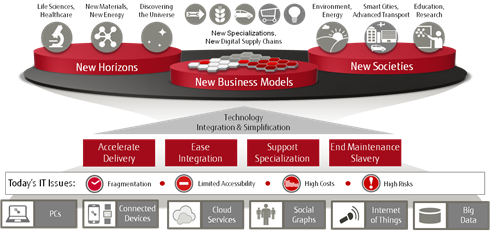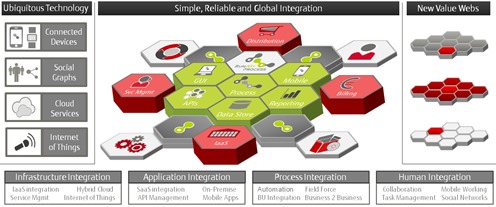Just a commentary in response to a post I found by by Peter Evans-Greenwood on the potential for business re-engineering based on presence-based technologies such as Apple’s iBeacon. While I don’t want to talk about this subject specifically, Peter uses a couple of very clear examples in terms of retail purchasing that illustrate the power of re-imagining desirable outcomes from the consumer’s perspective – as opposed to a technology perspective – and the resulting need to pursue consumer-focused integration of business capabilities to give them what they need.
These themes resonated with me this morning as I gave a talk at the Eurocloud congress recently in which I berated people for not “thinking big” about the potential of cloud in combination with other technologies. At the moment there is so much discussion and argument about whose VM is better or the benefits (or not) of making VMs more ‘enterprisey’ that everyone seems to be missing the ‘moon shot’ opportunity of integrating, simplifying and putting technology platforms into the hands of everyone. This problem only becomes more acute as you broaden your view to all of the other silo arguments raging across other areas of technology evolution. From this perspective Peter’s examples of design-led, consumer-oriented thinking were very similar to the challenge I tried to lay down to congress attendees.
Effectively I believe that the IT challenge of our generation is to package diverse technologies into much higher level platforms that humanise technology and empower less technical people to solve real problems – i.e. to enable them to use modelling and simplified domain languages to scalably and reliably address the huge opportunities that technology can deliver to science, business and society. It’s a shock to many IT people but more often than not it’s actually other people who have the domain knowledge required to change the world – which is why they don’t have the time to learn the technology. From their perspective everything related to traditional IT is a form of tax, a significant driver of risk and delay and at worst an insurmountable barrier to their activities. These problems become more acute as you scale down the size of organisation under consideration – to the point at which the vast majority of smart people are locked out of the ability to bring their expertise to bear in new digital business models.
If we take Peter’s examples of placing the consumer – rather than technology – at the heart of our endeavours then it feels to me as if many seemingly “hot” IT trends fail on this basic test and are simply a reflection of technology-led thinking. Doing isolated things better because we can – e.g. like Peter’s NFC example – is really just a way of increasing the efficiency of something that brings no benefit to the customer and is therefore just pointless when you step back and reflect. In Peter’s example the ‘customer’ from the technology provider’s perspective may have been the cashiers, the people who support payment systems or even the CIO. When you shift to an outside-in perspective, however, the obvious question is why make payment at the cash desk more efficient when there is no need to queue to pay at all?
I know it’s a difficult discussion but in a similar sense businesses rather than IT staff are the true customers of IT and their intent is ultimately to deliver new and valuable outcomes as quickly as possible – they really couldn’t care less whether your infrastructure is virtualised, what middleware is or whether the pointless technical activity required to undertake these tasks is managed by operations staff or developers. While they still have to ‘queue’ unnecessarily to get their outcomes it makes no material difference to their poor experience or the lack of empowerment offered by technology platforms. By stepping back we can see that most of the activity in cloud at the moment is not focused on re-imagining how we integrate and simplify IT to support the rapid achievement of new and customer-led business models but rather on how we provide tools and approaches to increase the efficiency of the people who have traditionally implemented IT. Again, this might make worthless tasks more efficient but effectively it’s like the payment example mentioned by Peter – in the same way that using NFC misses the opportunity for a wholesale rethink of the customer’s payment experience, I feel that most cloud activity (and certainly noise) is focused on achieving efficiency increases within the vast swathes of traditional IT activity which could be wholly eliminated using a design-led, outcome-centric approach.
In this context I believe that the major responsibility of cloud platform providers is to provide a simplified way of creating business solutions that span all of the different technologies, business capabilities and channels that are meaningful to the creation of business models. Essentially we need to enable businesses to ‘compose’ internal and external capabilities into new value webs supporting innovative new business models – all at a higher level of abstraction. I call this concept of rapid business model creation, integration and adaptation composite business. Essentially there should be no need for anyone other than cloud platform providers to understand the complexity of the different underlying technologies necessary to create, deliver and monetise systems that digitally encode business IP for such composite business models.
Realising a business platform for the support of composite business models requires the consideration of two different dimensions of integration and simplification:
- Firstly composite business platforms need to provide a cohesive experience to their users by integrating and simplifying all of the technologies, processes and tools required to deliver value outcomes via multi-layer business composition; such platforms cannot simply be a loose and low level collection of technologies and middleware that require ongoing integration, configuration and management by technical users.
- Secondly the platform itself needs to provide high leverage tools that a range of stakeholders can use to quickly capture, deliver, monetise and distribute their business IP as composite business and technology services. In this context a composite business platform needs to facilitate the simplified creation of solutions that integrate distributed and heterogeneous assets into new value webs – while hiding the technical complexity required to enable it.
In stepping back we need to realise the essentially pointless nature of technology implementation and management as an end in itself and focus on the ways in which we can make it disappear behind tools that simplify the realisation of valuable business outcomes. Such a re-imagining has never been more feasible – we now have a foundation of open networks, open protocols and open technologies that enable the creation of new and higher order platforms for value creation. From my perspective this is the responsibility of platform companies in the emerging business ecosystem and we only have to step back to see the opportunities.
In this context ‘cloud integration’ transforms from being a technical issue to an enabler to the rapid linkage of business and technology assets into new, consumer-centric value webs that can span industry boundaries and deliver new personalised services.
Furthermore while I believe that this shift has the short term potential to improve services from companies and organisations operating within settled industry boundaries, the outstanding business opportunities of our age are to put high leverage cloud platforms into the hands of the maximum number of people to democratise technology and allow organisations to pursue wholesale specialisation and the aggressive re-drawing of existing industry and social boundaries around value. I believe that we truly are on the verge of not just a new information industrial revolution that impacts IT companies but rather a whole new business revolution that will leverage the shift to utility platforms to change the basis of on which businesses compete. As the technology platform coheres, enterprises will increasingly be able to specialise, integrate and then focus their joint efforts around value to the end consumer rather than on maximising the utilisation of their own capabilities in pursuit of scale and efficiency (something that represents a ‘punctuated equilibrium’ in evolutionary terms – as I’ll continue to explore in part II of my recent post on this subject). As value webs can be quickly created, evolved and realigned to ‘pull’ everything into the experience required by the consumer, the old model of ‘pushing’ industrially or functionally siloed products and services from large and tightly integrated companies becomes insupportable.
So I would encourage you to read Peter’s post – to see some simple and concrete examples of design thinking in action – and then think about the ‘moonshot’ opportunity of a wholesale re-imagining of technology. With all of the myriad technology advances that we are seeing it has never been easier to create a simplified and reliable platform for the modelling, execution and monetisation of new kinds of business.
Finally, also take the time to really reflect on all of these opportunities in the context of your role and the ways in which you can truly add value in this new environment. If you are working in an enterprise then think hard about whether you really need to control the technology in order to realise business value for your organisation (hint – uh, no). On the other hand if you’re working in an IT company then think about how to hide the technology and enable IT groups to focus purely on business IP capture, management and distribution.


